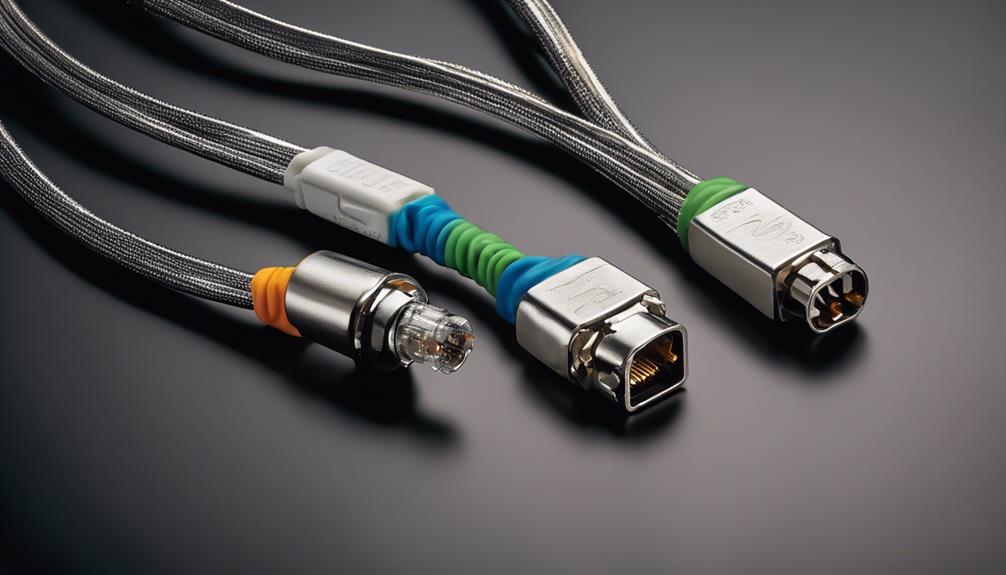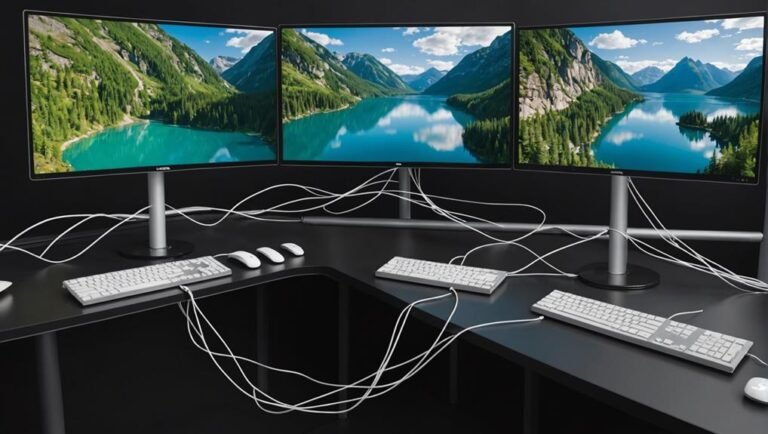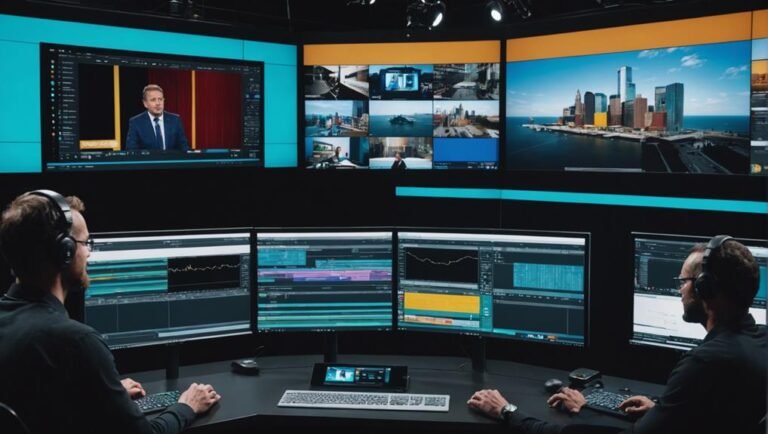If you’re looking to connect BNC devices to an Ethernet network, converting is the way to go. This process allows for seamless integration of analog systems with modern digital ones, enhancing range and efficiency. You can use BNC to Ethernet adapters or video encoders to bridge the gap, depending on your needs. For longer distances, active converters are ideal, while passive options suit shorter runs. By utilizing existing coaxial infrastructure, you save on costs. Want to know more about installation steps or equipment? There’s plenty of information to help you get started effectively!
Understanding BNC Connectors
BNC connectors, short for Bayonet Neill-Concelman, are vital components in the domain of video and radio frequency (RF) transmissions. If you’re diving into the field of broadcasting or audio-visual setups, understanding these connectors is significant. They’re designed for quick connections and disconnections, giving you the freedom to adapt your setup as needed.
These connectors feature a bayonet mount, which means you can securely lock them in place with a simple twist. This not only guarantees a stable connection but also prevents accidental disconnections, something you definitely don’t want while working on an important project. You’ll often find BNC connectors in applications like CCTV systems, test equipment, and professional video equipment, where reliability is key.
When you’re choosing BNC connectors, consider factors like impedance and cable type to guarantee optimum performance. The versatility of BNC connectors provides you with the flexibility to connect various devices, enhancing your ability to create the ideal setup. So, as you explore your options, remember that these connectors are more than just components; they’re tools that empower you to connect and transmit your ideas freely and effectively.
Benefits of BNC to Ethernet
Connecting BNC connectors to Ethernet can greatly enhance your network capabilities. By making this connection, you’re opening up a world of flexibility and potential. You get to combine the reliability of coaxial connections with the speed and efficiency of Ethernet. This means less downtime and a more stable connection, allowing you to focus on what really matters—your work and creativity.
One of the key benefits is the extended range. BNC connectors can transmit signals over longer distances without losing quality, which is essential for larger setups. You’ll also appreciate the cost-effectiveness; integrating BNC with Ethernet lets you leverage existing infrastructure, saving you money on new equipment.
Moreover, it gives you the freedom to scale your network as needed. You can easily add more devices without overhauling your entire system. Plus, the simplicity of setup means you can get started quickly, without dealing with complicated configurations.
In a world where connectivity is paramount, combining BNC with Ethernet means you’re not just keeping up—you’re staying ahead. Enjoy the benefits of enhanced performance, reliability, and the ultimate flexibility to adapt as your needs evolve.
Conversion Methods Overview
When you’re looking to convert BNC to Ethernet, it’s crucial to understand the various types of converters available. You’ll also want to explore different connection techniques and consider how performance may vary between them. Let’s break down these key points to help you make an informed choice.
Types of Converters
There are several types of converters available for transforming BNC signals into Ethernet formats, each designed to meet specific needs. Understanding these options can help you choose the right one for your setup.
- Active Converters: These require power and are ideal for long-distance transmission. They amplify the signal, ensuring minimal loss over the run.
- Passive Converters: These don’t need external power and are perfect for short connections. They’re simpler and often more cost-effective, but they may not maintain signal quality over longer distances.
- Ethernet over Coaxial Adapters: These specialized converters enable you to use existing coaxial cabling for Ethernet connections. They’re a great way to repurpose old infrastructure without major rewiring.
Choosing the right converter means considering factors like distance, budget, and existing infrastructure. Each converter type has its strengths, so weigh your options carefully. By selecting the one that aligns with your needs, you’ll enjoy a smoother changeover from BNC to Ethernet, keeping your network flexible and efficient. It’s all about freedom—freedom to connect in the way that works best for you.
Connection Techniques Explained
Understanding how to connect BNC to Ethernet involves exploring various conversion methods. You’ve got a few options at your disposal, each offering a unique approach to bridging the gap between these two technologies.
One popular method is using a BNC to Ethernet adapter. This device converts the BNC signal into a digital format, making it compatible with Ethernet devices. Just plug in your BNC cable, and the adapter will handle the rest.
Another approach is a video encoder. This piece of equipment takes your analog BNC signal and encodes it into a digital stream, which can be transmitted over an Ethernet network. It’s perfect for security cameras or surveillance systems, giving you the freedom to access your video feeds from virtually anywhere.
If you’re into DIY solutions, you might consider building your own converter using Raspberry Pi or similar microcontrollers. This option requires some technical know-how but allows for customization to suit your specific needs.
Whichever method you choose, connecting BNC to Ethernet can open up a world of possibilities, making your setup more versatile and adaptable to your needs.
Performance Considerations
How do the different conversion methods affect performance when connecting BNC to Ethernet? The choice of conversion method can greatly influence your network’s efficiency and reliability. Here’s what you need to take into account:
- Latency: Some conversion methods introduce delays. Choose a method that minimizes latency to guarantee real-time data transmission, especially if you’re dealing with streaming applications.
- Bandwidth: Different converters have varying bandwidth capabilities. If you’re transferring large files or high-definition video, opt for a converter that supports higher bandwidth to avoid bottlenecks.
- Signal Quality: The integrity of your signal matters. Confirm your conversion method preserves signal quality to reduce packet loss and maintain clarity, especially in surveillance or broadcasting scenarios.
Equipment Needed for Conversion
To convert BNC signals to Ethernet, you’ll need specific cables and adapters to guarantee proper connectivity. Additionally, having the right conversion devices is essential for a seamless shift. Let’s explore what you’ll need to get started.
Required Cables and Adapters
When you’re ready to make the switch from BNC to Ethernet, you’ll need a few essential cables and adapters to get the job done smoothly. The right tools can empower you to break free from outdated technology and embrace a more flexible network setup.
Here’s what you’ll need:
- BNC to RCA Cable: This cable allows you to connect your BNC devices to RCA inputs, which might be necessary for certain setups before shifting to Ethernet.
- Ethernet Cable (Cat5e or Cat6): A high-quality Ethernet cable is vital for maintaining fast speeds and reliable connections. Depending on your network’s requirements, opt for a Cat5e or Cat6 cable to guarantee peak performance.
- BNC to Ethernet Adapter: This adapter will help bridge the gap between your BNC devices and the Ethernet network, simplifying the conversion process and enabling seamless integration.
With these cables and adapters in hand, you’re well on your way to achieving a more liberated and efficient network. Embrace the change, and enjoy the benefits of modern technology!
Necessary Conversion Devices
Making the conversion from BNC to Ethernet requires specific conversion devices that facilitate the change in technology. You’ll need a BNC to Ethernet adapter, which acts as the bridge between your coaxial system and IP network. This device converts the BNC signal into a format that Ethernet can understand, ensuring seamless communication.
Another essential component is an Ethernet switch or hub. If you’re connecting multiple devices, this equipment allows you to expand your network effortlessly. You might also consider a network video recorder (NVR) if you’re working with video feeds, as it can manage and store your data securely.
Don’t forget about power over Ethernet (PoE) injectors or switches if your devices require power through the Ethernet cable. This can simplify your setup, reducing clutter and maintaining a clean installation.
Lastly, a good quality Ethernet cable is non-negotiable. Look for cables that meet your network speed requirements—Cat5e, Cat6, or higher depending on your needs. With these devices, you’ll be well-equipped to make the change and enjoy the freedom that comes with a more flexible networking solution.
Installation Steps and Tips
Installing a BNC to Ethernet connection can seem intimidating, but with the right steps and a bit of patience, you’ll have it up and running smoothly. Here’s a concise guide to help you through the installation process:
- Gather Your Tools: Before you start, make certain you’ve got all the necessary equipment, including BNC connectors, Ethernet cables, and any necessary converters. This’ll save you time and frustration later.
- Connect the Devices: Begin by connecting the BNC cable from your camera or device to the BNC port on your converter. Then, plug an Ethernet cable into the converter’s Ethernet port. Make sure all connections are secure to prevent any signal loss.
- Power Up and Configure: Once everything’s connected, power on your devices. You may need to configure settings on your network or camera software to guarantee they communicate properly. Follow the user manual for specific configuration steps.
Common Applications and Use Cases
BNC to Ethernet connections are widely used in various applications, particularly in surveillance systems and broadcasting environments. If you’re setting up a security camera system, for instance, you’ll find that these connections allow you to seamlessly integrate analog cameras with modern IP infrastructure. This means you can monitor your space from anywhere, giving you peace of mind and control over your environment.
In broadcasting, BNC to Ethernet connections facilitate high-quality video and audio transmission. Whether you’re working on a live event or streaming content, these connections guarantee that you maintain the integrity of your signals, allowing for a smooth and professional output.
Additionally, you might use BNC to Ethernet in industrial settings where remote monitoring is essential. By connecting various devices, you can gather real-time data and respond to any issues without being tied to a specific location.
Ultimately, the versatility of BNC to Ethernet connections empowers you to create customized solutions tailored to your needs. Whether it’s enhancing security, improving broadcasting capabilities, or monitoring industrial equipment, you’ve got the freedom to choose how to optimize your setup.
Frequently Asked Questions
Can BNC to Ethernet Be Used for Long-Distance Connections?
You can definitely use certain connections for long distances, but it’s essential to take into account signal degradation and interference. Choosing the right cables and equipment can help maintain quality over extended distances. Always plan wisely!
What Is the Maximum Data Transfer Speed for BNC to Ethernet?
The maximum data transfer speed varies depending on the specific technology you’re using. Generally, you can expect speeds up to 10 Mbps with older systems, while modern setups might reach 100 Mbps or more.
Are There Any Compatibility Issues With BNC to Ethernet Converters?
Ever tried fitting a square peg in a round hole? Compatibility issues can arise with converters, especially if your devices have different signal types or specifications. Always check compatibility before making your connection to guarantee smooth operation.
How Do I Troubleshoot BNC to Ethernet Connection Problems?
To troubleshoot connection issues, check all cables for damage, guarantee proper connections, and verify device settings. Restart your devices and test with different cables if necessary. Staying patient helps you resolve the problem effectively.
Is BNC to Ethernet Suitable for Streaming Video Content?
Did you know that over 80% of video content is streamed online? If you’re looking for a reliable connection, BNC to Ethernet can work, but make certain your setup supports the bandwidth needed for smooth streaming.



